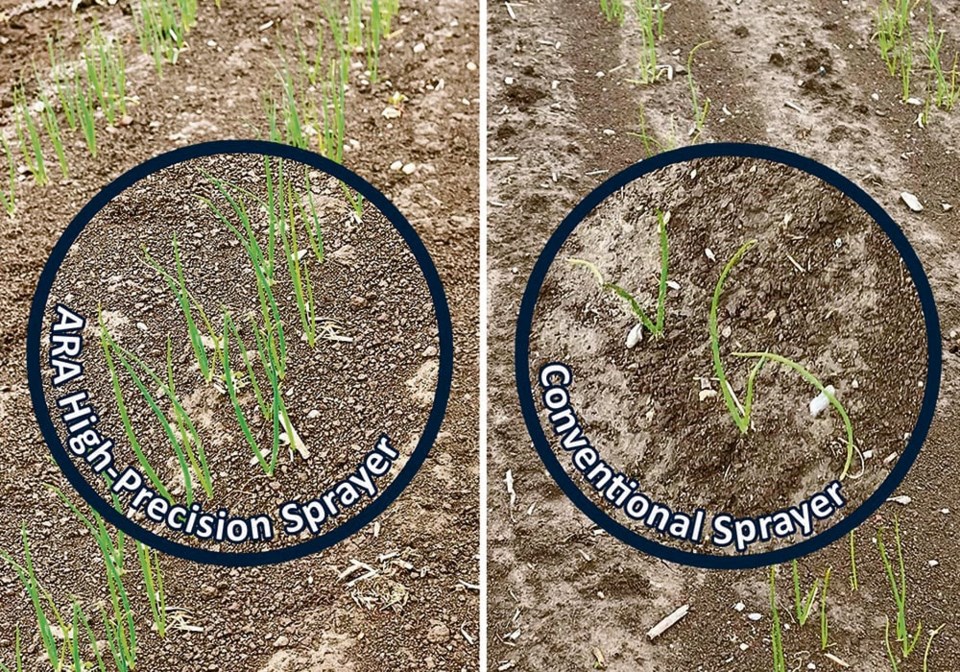WESTERN PRODUCER — Ecorobotix recently sold its first Canadian sprayers to two major Quebec vegetable growers who each crop more than 1,000 acres. They deliver fresh produce daily direct to New York and Boston.
One of those growers is Guillaume Cloutier.
“We use it every day,” he says.
“I think we’ve sprayed about 700 acres with it so far. We focus on our onion and lettuce fields first — then carrots and other crops.
“We are very happy with how the machine is simple to use, rapid and how the cameras can detect very small weeds. The people are very good with service and to help us. It’s not perfect yet, but they’re working to improve the algorithms so it works on our muck soil.”
Cloutier says muck soil on his farm averages 95 percent organic matter. This is the organic black soil left after draining a swamp or marshland. This moist organic substrate conserves water and releases plant nutrients. Loose soil particles allow root vegetables such as carrots and onions to grow big without much resistance from the soil.
“We can have a lot of wind damage on young plants, so we plant barley in when we seed the onions. The barley dies and lays flat on the field, but the algorithms need to be adjusted to compensate for that. They are using their AI so they will have the problem fixed in not much time.
“This new sprayer is not so slow as you might think. It’s seven km-h. That’s about how fast we go with our conventional open sprayer. In vegetables we only spray at eight km maximum. We can do a hundred acres in a day with this machine.
“We grow a total of 1,300 acres of vegetables and we have a lot of weed pressure. So we might spray each field eight or 10 times in a season. This machine saves up to 80 percent on the product we spray. One sprayer isn’t enough. We need one more. Maybe two more. We paid about $200,000 for this first sprayer. I see it will pay for itself in less than two years. In addition to spraying less chemical, there is also the fact that we hire less labour.”
He said that in normal soil with less weeds, a grower can reasonably expect a 90 percent cost saving on chemicals.
Martin Van Winden says he’s only had the unique sprayer two months, but already sees a dramatic reduction in the volume of applied crop protection products. So far he has sprayed 300 acres of lettuce with the Ecorobotix, but will use it later this summer for shallots and onions.
“We didn’t need to do anything but go to the fields, fill the tanks and start spraying. We are impressed with its speed. Being able to do such precise spraying at 4.7 m.p.h. is amazing. There’s no waste because it just sprays on the target spot. I think we’ll see that we can cut back 80 or maybe 85 percent on chemicals,” Van Winden said.
Both farms plan to use their Ecorobotix ARA to apply different kinds of phytosanitary products. Cloutier calculates the savings on chemical use will allow him to pay off the machine in one to two cropping seasons. Phytosanitary product savings are not the only benefit — there’s also an increase in crop yields due to a reduction of phytotoxicity and manual labour.
In a side-by-side field demonstration, an onion field was divided into two parts to compare phytotoxicity in crop herbicide treatment between a conventional application and the Ecorobotix ARA ultra-precision sprayer.
One section was sprayed with the Ecorobotix ARA ultra-precision sprayer on the weeds without touching the onions. The other section received a blanket application with a conventional sprayer.
Onions sprayed with the conventional sprayer are considerably smaller than onions in the plots sprayed with EcorootixARA.
Overall, crop health with the ARA sprayer seems much higher than with the conventional spraying method, even when increasing the dosages of the herbicides used. Conventionally sprayed onions experienced higher mortality, Van Winden said.



